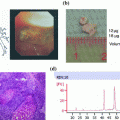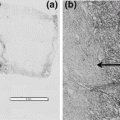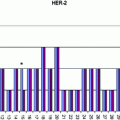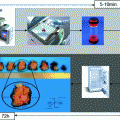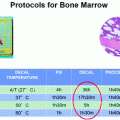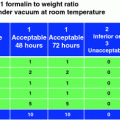© Springer International Publishing Switzerland 2015
Manfred Dietel, Christian Wittekind, Gianni Bussolati and Moritz von Winterfeld (eds.)Pre-Analytics of Pathological Specimens in OncologyRecent Results in Cancer Research19910.1007/978-3-319-13957-9_4Tissue Heterogeneity as a Pre-analytical Source of Variability
(1)
Department of Medical Sciences, University of Trieste, c/o Ospedale di Cattinara, Strada di Fiume, 447, 34149 Trieste, Italy
A low level of reproducibility is the shortcoming of clinical studies where human tissues are used, especially in oncology [1, 2]. This could be due to the high variability of the pre-analytical conditions of tissue managing and preservation, but also to other two causes. One is the low level of standardization of the methods that is pertinent to the analytical phase. Heterogeneity of tissues is the other problem and it can be considered to be actually related to pre-analytical procedures. Indeed, it is a pre-condition that has to be taken into consideration before the specific analysis. Not all the consequences of heterogeneity can be more or less easily avoided by carefully choosing the tissues to be analyzed. Some types of heterogeneity are strictly related to the complexity of the carcinogenesis phenomena and are not easy to localize with a proper micro-dissection. It is anyway possible to improve reproducibility of tissue molecular analysis by taking into consideration at least some of the aspects of tissue heterogeneity. It is also important to recognize that different types of molecular analyses can be differently affected. Gene expression analysis is even more perturbed than DNA sequencing by which only different genetic cell populations can be recognized in the same sample.
1 Different Types of Heterogeneity
Different types of heterogeneity have to be considered when analyzing human cancer tissues for diagnostic or clinical research purposes. We have to consider macroscopic, microscopic, and molecular types of variation. Macroscopic heterogeneity is the clinical variation in patients, such as type of tumor and treatment, or patients’ age and gender. This type of clinical heterogeneity is strictly related to the design of the study and, if properly driven, it does not affect the result reproducibility of a study because these characteristics have been chosen and well known from the beginning of the research. In most cases, this clinical variability is the reason why the study was performed and is not considered in this paper.
Other types of heterogeneity are more insidious, like heterogeneity in cancer tissues or the more recently detected molecular heterogeneity related to clonal evolution or autocrine, paracrine cell interaction (Box 1). These types of heterogeneity can heavily affect the results of molecular analyses at the clinical and research level and should be considered as the most important cause for the scarce reproducibility of clinical research. On the other hand tissue related heterogeneity is well recognized but very often under-evaluated as a source of analytical variability, especially in clinical research but sometimes also at the diagnostic level and it sure can be improved. Molecular heterogeneity is more complex and still in a research phase. At the moment we do not have sufficient information to manage the problem properly.
Heterogeneity in cancer tissues is one of the characteristics that suggest a multidisciplinary approach. Clinical heterogeneity must be evaluated mostly by oncologists, tissue related heterogeneity can only be tackled by an experienced pathologist and molecular heterogeneity is still at the center of a research process and must be evaluated by experts in molecular biology, oncology, and pathology.
Box 1: Different Types of Heterogeneity Affecting Diagnosis or Clinical Research
Clinical Heterogeneity related to different patients’ conditions (different tumor type, ethnicity, age, therapy, etc.)
Tissue Related Heterogeneity
Related to tissue complexity (fibrosis, inflammation, necrosis, normal residual tissues…)
Related to histological heterogeneity (different differentiation pattern of the same tumor)
Different functional areas (border vs center of the tumor)
Molecular Heterogeneity
Genetic clonal evolution
Epigenetic clonal evolution
Phenotypic plasticity
Heterotypic interaction
1.1 Tissue-Related Heterogeneity
Tissue-related heterogeneity is a well-known pattern that is always detectable in cancer tissues at a more or less high degree. Sometimes this variability is of very low level and does not affect molecular analysis, but sometimes it can give highly contradictory results depending on the analyzed area. It is possible to recognize at least three types of this kind of heterogeneity. The first one is related to tissue complexity. Tumor tissues do not only contain cancer cells but a variable degree of fibrosis that is characteristic of the tumor type as a desmoplastic reaction. It could also be related to the size of the tumor with central necrosis substituted by a dense fibrosis due to insufficient neo-angiogenesis and related hypoxia. In most tumors there are also cells with normal genome, such as reactive inflammatory cells that are part of the carcinogenetic process, or residues of normal tissues involved in the invasion process. It is easy to realize how the presence of one or more of these cancer tissue components, especially if they are quantitatively relevant, can completely alter the results of molecular analysis, giving false positive or negative results. This is usually the only tissue heterogeneity taken today into account during tissue micro-dissection, when histological examination is performed and mechanical or laser dissection is suggested. In many tumors such as breast and colon cancer, it is common to find normal tissue together with the neoplasia in histological specimens and this mixture is often accepted in the sample analyzed for diagnostic molecular signatures such as Mammaprint, Oncotype DX, PAM50. It has been shown that the presence of normal tissue can modify, even if in a limited quantity, the category of risk to a less aggressive than the one detected in the pure breast tumor tissue [3].
A more complicated type of heterogeneity is the one related to different histological patterns in the same tumor, which sometimes could also represent different levels of molecular differentiation. At the moment this phenomenon is still badly defined and deserves more attention by pathologists and molecular biologists. For example, we could expect to find differences when analyzing differentiated and anaplastic areas of the same tumor that can often be found in human cancers. We need to better define those characteristics not only in a general way but also for specific types of tumors, by evaluating the importance of this factor in the reproducibility of molecular analysis in diagnostics and clinical research.
For quite a long time we have been aware that there are different functional areas in a tumor such as borders and the center of an invasive neoplasia that display different gene expression patterns [4]. Usually the central part of the tumor is more affected by hypoxia and cellularity is low with a higher fibrotic component, whereas the border can be crowded with cells with activated proteolytic enzymes and a more frequent interaction with reactive cells. The border itself can give better information on the aggressiveness of the tumor. When the tumor is large and the position of the analyzed tissues is unknown, this can heavily affect molecular diagnostics and research analyses.
Of course there are differences in tissue heterogeneity among tumour types and a more complete analysis is necessary to establish specific characteristics. However it is possible to consider some general rules that could help a higher level of standardization like those reported in Box 2.
Very short time between cutting micro-dissected area sections and the extraction of nucleic acids (especially for RNA) should pass, otherwise this could be another pre-analytical source of variability due to possible further degradation of nucleic acids by contamination of environment nucleases.
Box 2: Suggestions for a Practical Approach to Tackle Tissue Heterogeneity
Small biopsies
1.
Histological evaluation of tissues
2.
When possible micro-dissection (including border of the tumor and avoiding stroma, normal t. residues)
3.




Digital record of the selected tissues
Stay updated, free articles. Join our Telegram channel

Full access? Get Clinical Tree



